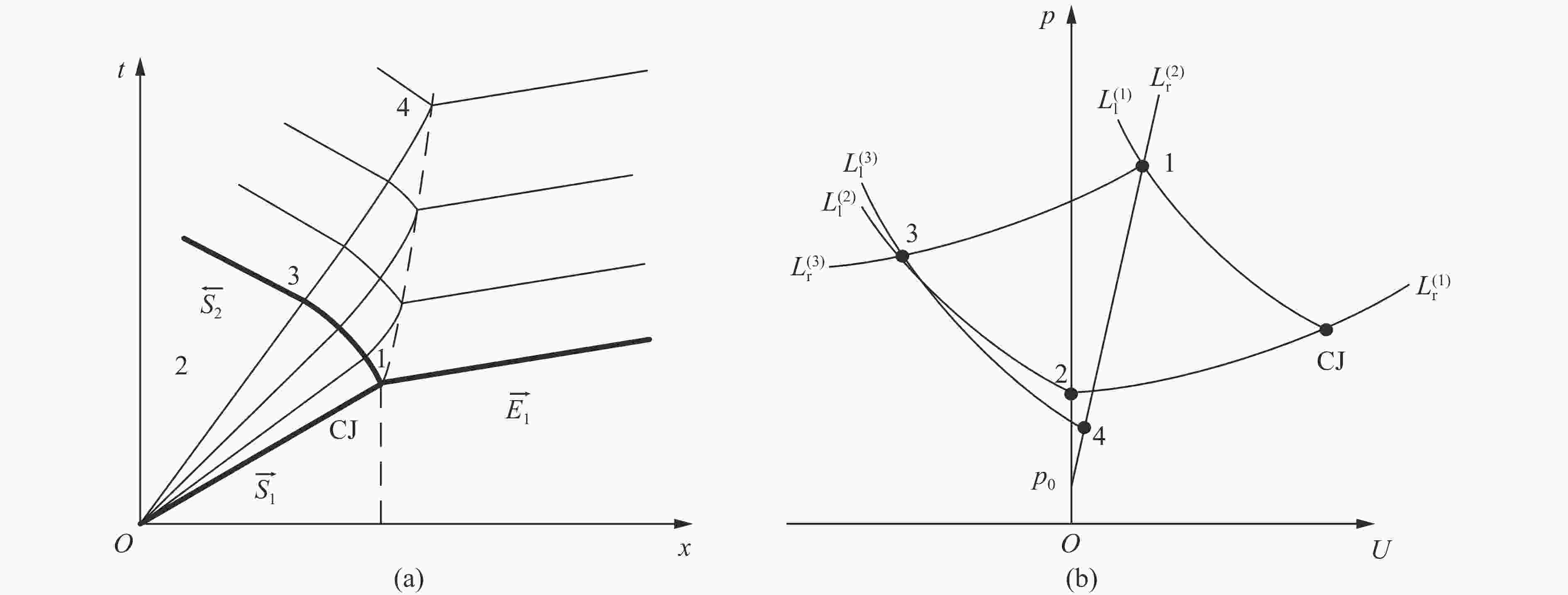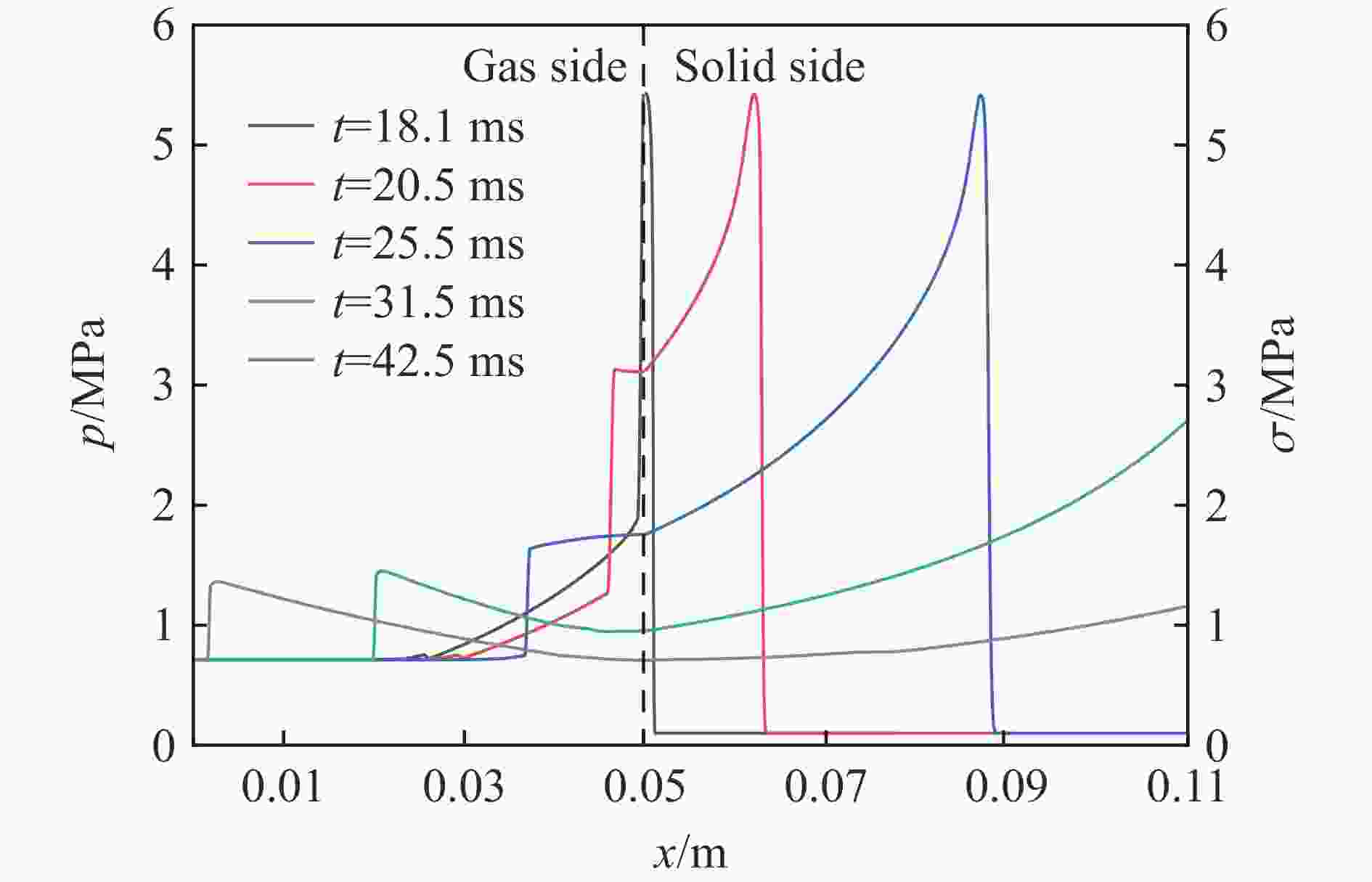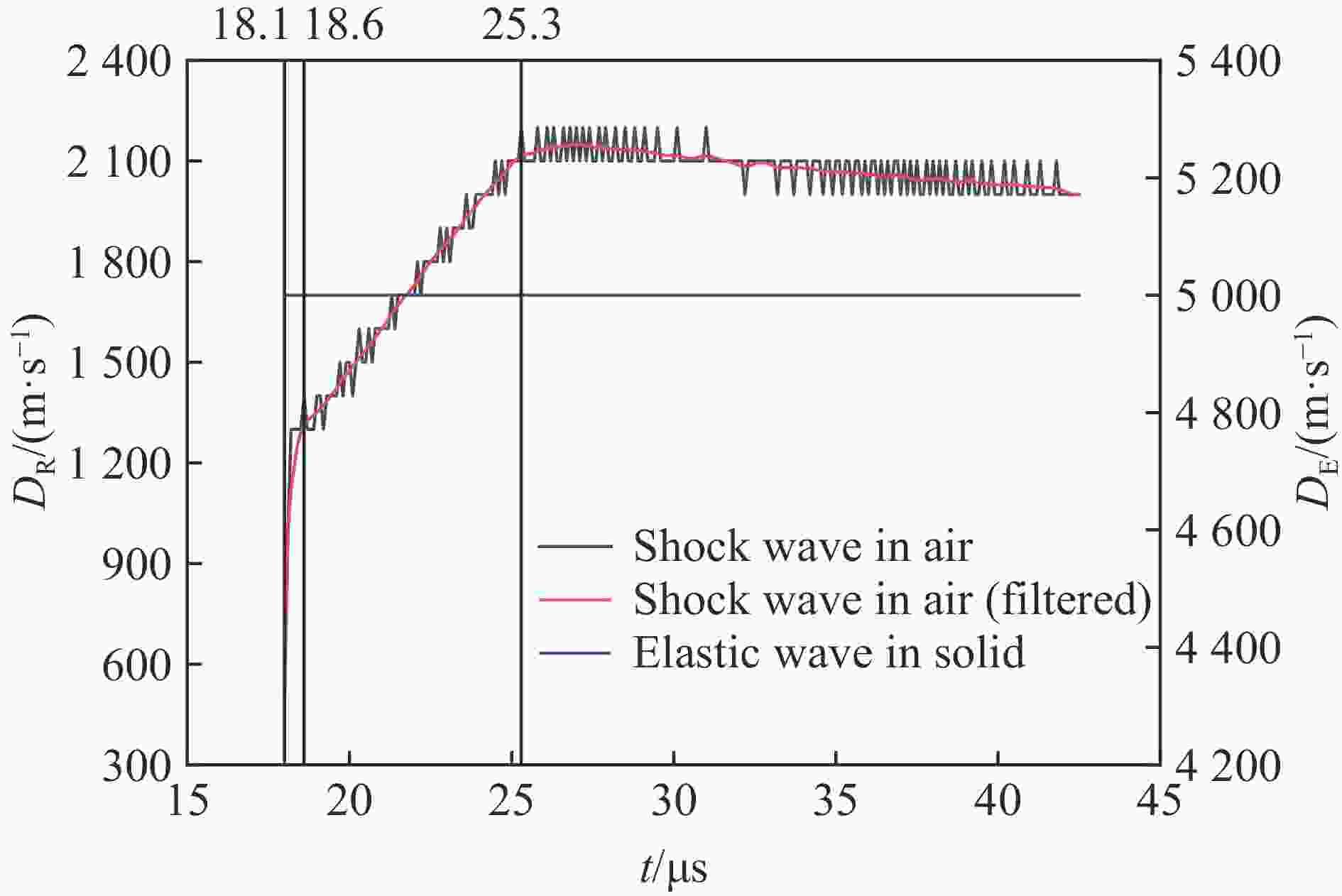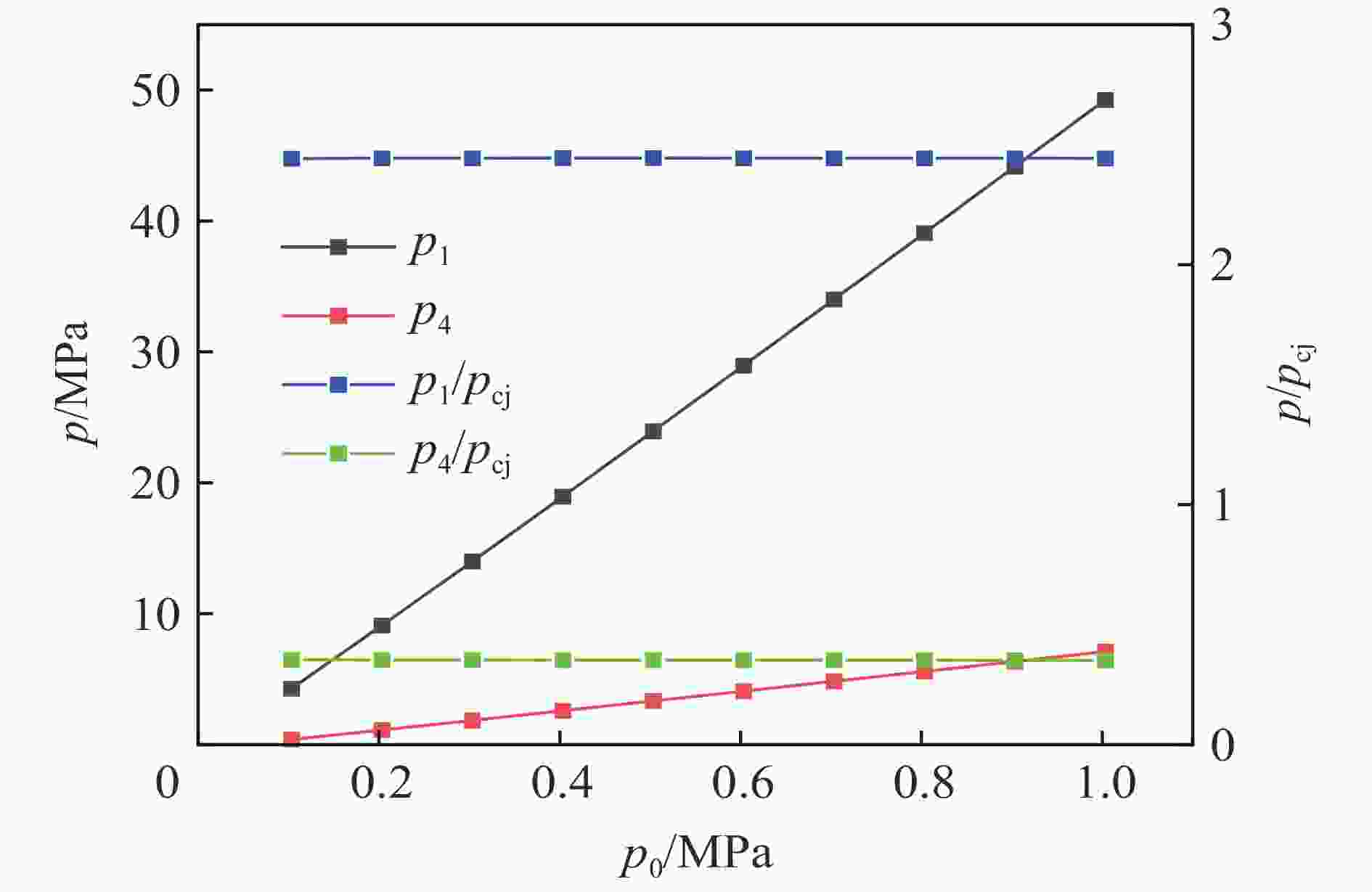Transmission and reflection characteristics of gaseous detonation waves impacting on gas-solid interface
-
摘要: 为了研究气相爆轰波冲击气固界面过程中透射波和反射波的相关特性,建立爆轰波冲击气固界面的一维理论模型,对不同初始压力条件下爆轰波到达气固界面后的界面两侧的压力和界面速度变化进行分析。利用时空守恒元求解元方法对气相爆轰波冲击气固界面过程进行数值模拟,分析气体部分反射波的压力分布和速度变化规律及透射入固体中应力波的波形和波速特征,并搭建气相爆轰波冲击活塞实验装置进行进一步验证。结果表明:气体爆轰波到达气固界面后,在固体中透射指数形式的弹性波,并在界面处向气体区反射一道激波。爆轰波后的稀疏波与反射激波相交,削弱反射激波,最终形成稳定激波回传。气固界面在稀疏波和反射稀疏波的作用下,压力和速度逐渐下降,最终也形成稳定状态。在不同混气初始压力情况下,爆轰波冲击过程中产生的最高压力和爆压的比值基本保持不变。理论模型对特征点相关物理量的计算值和实验数据符合的较好。Abstract: The correlation characteristics of transmitted and reflected waves in the process of impact of the gas-solid interface by the gaseous detonation wave are of great engineering significance. A one-dimensional theoretical model was established to analyze the process of the detonation wave impacting the gas-solid interface. The changes in the pressure and interface velocity on both sides of the interface with different initial pressures after the detonation wave reaching the gas-solid interface were analyzed. The process of the gas-solid interface impacted by the gas-phase detonation wave was numerically simulated. The space-time conservation element and solution element (CE/SE) method and the elementary reaction mechanism were used to simulate the gaseous detonation, and the immersed boundary method (IBM) was used to simulate the fluid-structure interaction. The pressure distribution, rules of velocity change of partial reflection wave of gas, and the waveform and velocity characteristics of stress wave transmitted into solid were analyzed. An experimental device of the impact of the piston by gaseous detonation was built and used for further verification. The results show that after the gaseous detonation wave reaches the gas-solid interface, the elastic wave in the exponential form is transmitted in the solid, and a shock wave is reflected in the gas zone at the interface. The rarefaction wave after the detonation wave intersects with the reflected shock wave, which weakens the reflected shock wave. In this process, the pressure after the reflected shock wave decreases, and the wave velocity becomes faster. The pressure in the intersection area of the original and reflected rarefaction waves remains uniform. Finally, the reflected shock wave becomes stable, and the gas-solid interface forms a constant state. Under different initial pressures of the same mixture, the ratio of maximum pressure to detonation pressure in the process of the impact of the detonation wave remains stable. The theoretical model is consistent with the calculated values and experimental data of related physical quantities at the feature points.
-
Key words:
- detonation wave /
- gas-solid interface /
- reflected shock wave /
- stress wave
-
表 1 网格收敛性模拟结果
Table 1. Simulation results of mesh convergence
网格尺寸/mm 波后压力/MPa 波速/(m·s−1) 0.1 2.13 2800 0.04 2.45 2800 0.02 2.61 2840 0.01 2.77 2833 0.004 2.82 2835 表 2 特征状态压力的理论、数值和实验结果
Table 2. Theoretical, numerical and experimental results of characteristic state pressure
p1/MPa 理论 数值模拟 误差 理论 实验 误差 4.6467 5.4245 16.74% 4.6467 4.73 1.79% p4/MPa 理论 数值模拟 误差 理论 实验 误差 0.6991 0.7012 0.30% 0.6991 0.71 1.56% -
[1] 李海鹏, 何立明, 周鑫. 脉冲爆震发动机性能对爆震室材料强度的需求 [J]. 机械科学与技术, 2007, 26(5): 623–625. DOI: 10.13433/j.cnki.1003-8728.2007.05.019.LI H, HE L M, ZHOU X. Pulse detonation engine ’s requirements for material strength of its detonation chamber [J]. Mechanical Science and Technology for Aerospace Engineering, 2007, 26(5): 623–625. DOI: 10.13433/j.cnki.1003-8728.2007.05.019. [2] 马华原, 龙源, 谢全民, 等. 浅埋高压输气管道爆炸地面振动的原型试验与数值模拟研究 [J]. 爆炸与冲击, 2019, 39(10): 102201. DOI: 10.11883/bzycj-2018-0303.MA H Y, LONG Y, XIE Q M, et al. Prototypical experiment and numerical simulation of ground vibration resulting from explosion in shallowly buried gas pipelines [J]. Explosion and Shock Waves, 2019, 39(10): 102201. DOI: 10.11883/bzycj-2018-0303. [3] 王德明. 煤矿热动力灾害及特性 [J]. 煤炭学报, 2018, 43(1): 137–142. DOI: 10.13225/j.cnki.jccs.2017.4300.WANG D M. Thermodynamic disaster in coal mine and its characteristics [J]. Journal of China Coal Society, 2018, 43(1): 137–142. DOI: 10.13225/j.cnki.jccs.2017.4300. [4] LIEBERMAN D H, SHEPHERD J E. Detonation interaction with an interface [J]. Physics of Fluids, 2007, 19(9): 096101. DOI: 10.1063/1.2768903. [5] 于明, 刘全. 凝聚炸药爆轰波在高声速材料界面上的折射现象分析 [J]. 物理学报, 2016, 65(2): 024702. DOI: 10.7498/aps.65.024702.YU M, LIU Q. Refraction of detonation wave at interface between condensed explosives and high sound-speed material [J]. Acta Physica Sinica, 2016, 65(2): 024702. DOI: 10.7498/aps.65.024702. [6] TANG Y K C, MI X C, LEE J H S, et al. Transmission of a detonation across a density interface [J]. Shock Waves, 2018, 28: 967–979. DOI: 10.1007/s00193-018-0827-z. [7] PEACE J T, LU F K. Detonation-to-shock wave transmission at a contact discontinuity [J]. Shock Waves, 2018, 28: 981–992. DOI: 10.1007/s00193-018-0804-6. [8] DAMAZO J, SHEPHERD J E. Observations on the normal reflection of gaseous detonations [J]. Shock Waves, 2017, 27: 795–810. DOI: 10.1007/s00193-017-0736-6. [9] 张洋溢, 龙源, 何洋扬, 等. 爆轰波斜冲击金属介质理论在聚能装药药型罩设计中的应用研究 [J]. 振动与冲击, 2011, 30(7): 214–217. DOI: 10.13465/j.cnki.jvs.2011.07.035.ZHANG Y Y, LONG Y, HE Y Y, et al. Applied research on the oblique impact theory of detonation waves at the explosive-metal interface in design of shaped charge [J]. Journal of Vibration and Shock, 2011, 30(7): 214–217. DOI: 10.13465/j.cnki.jvs.2011.07.035. [10] 周宁, 张冰冰, 冯磊, 等. 反射波对预混气体爆炸过程与管壁动态响应的影响 [J]. 爆炸与冲击, 2016, 36(4): 541–547. DOI: 10.11883/1001-1455(2016)04-0541-07.ZHOU N, ZHANG B B, FENG L, et al. Effects of reflected wave on premixed-gas explosion and dynamic response of tube shells [J]. Explosion and Shock Waves, 2016, 36(4): 541–547. DOI: 10.11883/1001-1455(2016)04-0541-07. [11] 郑龙席, 李少华, 卢杰, 等. 真实爆震载荷作用下爆震室等寿命设计方法 [J]. 航空动力学报, 2017, 32(9): 2055–2062. DOI: 10.13224/j.cnki.jasp.2017.09.002.ZHENG L X, LI S H, LU J, et al. Design method of equal life on detonation combustor under actual detonation loading [J]. Journal of Aerospace Power, 2017, 32(9): 2055–2062. DOI: 10.13224/j.cnki.jasp.2017.09.002. [12] LI H W, GUO J, YANG F Q, et al. Explosion venting of hydrogen-air mixtures from a duct to a vented vessel [J]. International Journal of Hydrogen Energy, 2018, 43(24): 11307–11313. DOI: 10.1016/j.ijhydene.2018.05.016. [13] PORTARO R, SADEK J, XU H, et al. Controlled release using gas detonation in needle-free liquid jet injections for drug delivery [J]. Applied Sciences, 2019, 9(13): 2712. DOI: 10.3390/app9132712. [14] WANG W T, WANG X, MENG C M, et al. Characteristics of the seismic waves from a new active source based on methane gaseous detonation [J]. Earthquake Research in China, 2019, 33(2): 354–366. DOI: 10.19743/j.cnki.0891-4176.201902003. [15] DU Y, ZHOU F, HU W, et al. Incremental dynamic crack propagation of pipe subjected to internal gaseous detonation [J]. International Journal of Impact Engineering, 2020, 142: 103580. DOI: 10.1016/j.ijimpeng.2020.103580. [16] 高健, 姚安仁, 冯鲁煜, 等. 烈性爆震下活塞材料破坏实验 [J]. 燃烧科学与技术, 2020(2): 120–124. DOI: 10.11715/rskxjs.R201901022.GAO J, YAO A R, FENG L Y, et al. Experimental study on the piston material failures under detonation [J]. Journal of Combustion Science and Technology, 2020(2): 120–124. DOI: 10.11715/rskxjs.R201901022. [17] 高光发. 波动力学基础[M]. 第1版. 北京: 科学出版社, 2019: 225. [18] 严传俊, 范玮. 脉冲爆震发动机原理及关键技术[M]. 第1版. 西安: 西北工业大学出版社, 2005: 43. [19] 李维新. 一维不定常流与冲击波[M]. 第1版. 北京: 国防工业出版社, 2003: 262. [20] IM K S, JOH S T, KIM C K, et al. Application of the CESE method to detonation with realistic finite-rate chemistry [C] // 40th AIAA Aerospace Sciences Meeting & Exhibit. 2002. DOI: 10.2514/6.2002-1020 [21] ROKHY H, SOURY H. Fluid structure interaction with a finite rate chemistry model for simulation of gaseous detonation metal-forming [J]. International Journal of Hydrogen Energy, 2019, 44(41): 23289–23302. DOI: 10.1016/j.ijhydene.2019.07.030. [22] FADLUN E A, VERZICCO R, ORLANDI P, et al. Combined immersed-boundary finite-difference methods for three-dimensional complex flow simulations [J]. Journal of Computational Physics, 2000, 161(1): 35–60. DOI: 10.1006/jcph.2000.6484. [23] GORDON S, MCBRIDE B J. Computer program for calculation of complex chemical equilibrium compositions and applications. Part 1: Analysis[M]. Washington: NASA Reference Publications, 1994: 39–40. [24] 冯明德, 彭艳菊, 刘永强, 等. SHPB实验技术研究 [J]. 地球物理学进展, 2006, 21(1): 273–278.FENG M D, PENG Y J, LIU Y Q, et al. Study of SHPB technique [J]. Progress in Geophysics, 2006, 21(1): 273–278. [25] 陈东华, 王立权. 两类冲击杆端部的二维数值分析及实验研究 [J]. 哈尔滨工程大学学报, 2016, 37(5): 707–712. DOI: 10.11990/jheu.201504055.CHEN D H, WANG L Q. Two-dimensional numerical analysis and experimental study of two types of impact bars [J]. Journal of Harbin Engineering University, 2016, 37(5): 707–712. DOI: 10.11990/jheu.201504055. -







 下载:
下载:








